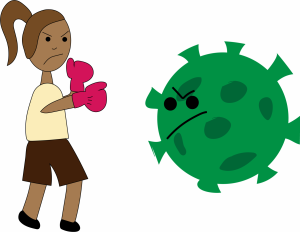How to Keep Your COVID-19 Guard Up While Enjoying Summer
The risk of COVID-19 transmission is reduced outdoors in comparison to enclosed spaces. Those spending time outside this summer should still be sure to adhere to proper precautions, including social distancing and wearing masks.
July 7, 2020
As members of the Fordham community spread out across the country, the decision of whether it’s safe to go out will vary from state to state and person to person. Referring to local protocols and the information provided by the Centers for Disease Control and Prevention (CDC) are the best ways to make an informed decision about what summer activities are safe.
Individual Safety
First and foremost, if you have COVID-19 or symptoms consistent with COVID-19, the CDC recommends staying home as much as possible. The same is true for those who may have been exposed to the virus through close contact with a positive individual.
If the above criteria does not describe you, here’s what to consider next. Generally speaking, “the more closely you interact with others and the longer that interaction, the higher the risk of COVID-19 spread,” according to the CDC.
An important question to consider is how many people you will come in contact with when engaging in an activity. The more people present, the more chances there are of one of those individuals harboring the virus. Therefore, small groups or one-on-one interactions are preferable to large groups of people.
It’s also important to consider whether or not it’s possible to maintain 6 feet of distance between you and everyone else. Indoor activities are less conducive to this social distancing measure, especially since space to spread out might be limited and poor ventilation may keep the virus in the air. Wearing a mask, especially while in a relatively crowded indoor environment, is tantamount to preventing COVID-19 spread.
Examine Each Location
Though some activities may meet these guidelines, extra caution should be taken if you are in an area where COVID-19 cases are increasing, currently in Florida, Texas and Oklahoma, to name a few.
While this information may seem like a lot to consider, additional precautions need to be taken when engaging in certain activities like visiting a restaurant that has reopened.
Each state is phasing out restrictions on business differently. For instance, restaurants in New York City are allowed to serve patrons outdoors as of June 22, whereas Florida restaurants have been able to serve up to 50% of their indoor capacity since June 5.
The CDC recommends checking up on any eatery via their social media or website to see how they are handling COVID-19 safety. The CDC specifically advises individuals to ask ahead as to whether the restaurant workers are wearing masks. Though indoor seating is allowed in Florida, the CDC still recommends limiting time spent in indoor spaces without a mask, so make sure to prefer outdoor seating and maintain 6 feet away from patrons who are not part of your household.
Some other important points to consider include avoiding self-serve food, when possible. Lastly, wash your hands for at least 20 seconds with soap and water or cleanse them with 60% alcohol-based hand sanitizer when you enter and leave the establishment.
Outdoor Activities
If keeping track of all these precautions seems arduous, electing to spend your summer leisure time outside at parks or beaches may seem less so.
There are two factors that reduce the risk of COVID-19 transmission outdoors. First, if someone were sick while being outdoors, environmental factors like the wind would cause the droplets the person expels to quickly disperse into smaller quantities. This may seem like the virus may have a better chance of getting to you, but the viral load, the amount of virus someone needs to come in contact with in order to get sick, is greatly reduced.
A Chinese study of 318 outbreaks demonstrates the level of risk spending time outdoors entails. Only one outbreak occurred outdoors in this study, and the instance involved transmission while an infected individual had a conversation with another person who subsequently became exposed.
Though the risk of transmission is lower outdoors, it’s not impossible to become infected while engaging in outdoor activities. Wearing a mask when maintaining 6 feet of distance is not possible and limiting extended interactions with individuals outside of your home are ways to prevent catching COVID-19.
After spending a large portion of the last three months indoors, it’s only natural to feel the urge to return to the normalcy of dining at a restaurant or sunbathing at the beach. Nevertheless, the best ways of preventing COVID-19 spread still involve personal hygiene measures and social distancing, so it’s important to allow yourself to enjoy the fun and freedom of the outdoors while also remaining aware of how to do those activities safely.

















